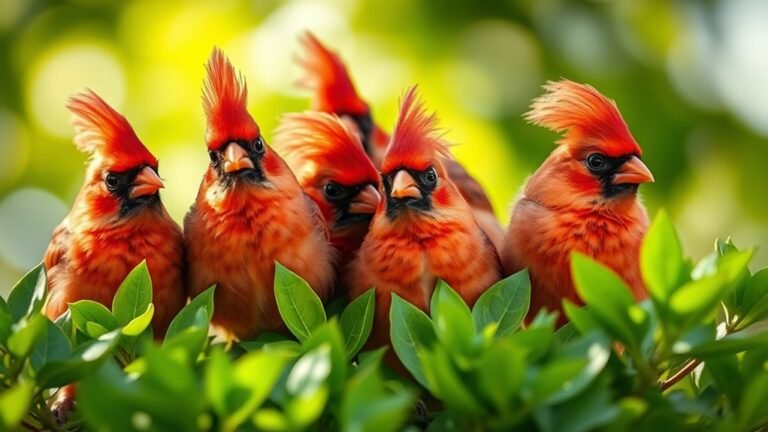How Do I Keep Predators Like Cats and Squirrels Away From Nest Boxes?
To keep predators like cats and squirrels away from your nest boxes, consider several straightforward strategies. First, place your nest boxes in locations that are less accessible to these animals. Second, install guards or barriers around the boxes to deter climbing. Third, use natural deterrents, such as strong scents that animals dislike.
Additionally, maintaining a clean environment is crucial. Remove any food sources or debris that might attract predators. By combining these actions, you can create a safer space for nesting birds. What steps will you take to improve the security of your nest boxes?
Key Takeaways
- Use metal mesh or PVC tubing as predator guards to keep cats and squirrels away from nest boxes.
- Install nest boxes 6-10 feet high to limit access for ground predators.
- Place nest boxes near dense shrubs or trees for cover, making it harder for predators to see them.
- Grow aromatic herbs like rosemary and mint nearby; their strong scents can help repel predators.
- Check and maintain nest boxes regularly to fix any openings that predators could use to access them.
Choosing the Right Location for Nest Boxes
When choosing a location for nest boxes, safety and accessibility are key. Place nest boxes at a height of six to ten feet off the ground. This height keeps many ground predators away while allowing for easy maintenance.
Consider the surrounding vegetation. Nest boxes near dense shrubs or trees offer cover for birds, making it harder for cats and squirrels to find them.
Also, ensure the location is sheltered from harsh weather and away from busy human areas.
Installing Predator Guards and Baffles
To improve the safety of your nest boxes, install predator guards and baffles. Choose from different types of predator guards such as metal mesh, plastic shields, or PVC tubing. Each type provides different levels of protection against cats and squirrels.
Select a guard based on the threats in your area and the size of your nest box.
For baffle installation, place the baffles at least 5-6 feet above the ground. Ensure they're securely attached to the pole or tree. A well-installed baffle should extend horizontally and have a smooth surface to prevent climbing.
Utilizing Natural Deterrents
Installing physical barriers is important for protecting your nest boxes. You can also use natural deterrents to improve their safety.
One effective method is to plant herbs that repel predators. Choose rosemary, mint, or lavender. Their strong scents can keep curious cats and squirrels away while enhancing the beauty of your garden.
Another helpful strategy is using essential oils. Sprinkling diluted oils like peppermint or citrus around your nest boxes can make the area less inviting for unwanted visitors.
Reapply these natural solutions regularly to keep them effective. By using these methods, you protect your nests and create a pleasant garden space that supports birds.
Creating a Bird-Friendly Environment
Creating a bird-friendly environment involves more than just keeping predators away; it means creating a space that meets the needs of different bird species.
You can make your outdoor area more inviting to birds by following these simple steps:
- Plant native plants that provide food and shelter for birds.
- Set up feeders that minimize waste and keep larger animals away.
- Maintain clean water sources for birds to drink and bathe.
By following these steps, you can attract a variety of birds to your yard while ensuring their safety and well-being.
Enjoy watching the birds thrive in your welcoming space!
Regular Maintenance and Monitoring
Regular maintenance and monitoring of your nest boxes are important for keeping birds safe. Inspect your nest boxes regularly to spot signs of wear, damage, or pests. Look for any openings that predators, like cats or squirrels, could use to enter. Take action to fix these issues.
Also, assess the area around the nest boxes. Ensure the environment is suitable for bird nesting. Check for overhanging branches or clutter that may attract unwanted animals.
Frequently Asked Questions
What Types of Birds Are Most Vulnerable to Predators?
Birds that nest on the ground, such as quails and shorebirds, are highly vulnerable to predators. Their nests lack protection, making them easy targets for animals that hunt in their habitats.
How Can I Identify Predator Tracks Near My Nest Boxes?
To identify predator tracks near your nest boxes, look for clear footprints in the soil. Pay attention to the size and shape of the tracks. Note any claw marks, as they can help you figure out which animal may be a threat. This simple observation can alert you to potential dangers for your nests.
Are Certain Bird Species More Aggressive Against Predators?
Certain birds, like American robins and blue jays, show aggression to protect their nests from predators. They defend their territory and scare away threats. This behavior helps their young survive.
What Time of Year Are Predators Most Active?
Predators are most active in spring. During this time, they hunt for food to feed their young. Knowing this seasonal behavior can help you protect your nesting birds effectively. By staying informed about predator activity, you can take steps to safeguard your birds and ensure their safety.
Can I Use Noise to Deter Predators Effectively?
Using sound can help deter predators. High-frequency noises may interfere with their ability to hunt. Lower-frequency sounds might not be as effective. Try different noise frequencies to find what works best for your situation.

Ava is a bird enthusiast and nature lover who has spent countless hours observing and learning about the fascinating world of birds. With a passion for sharing her knowledge and inspiring others to appreciate the beauty of birds, Ava writes about her experiences and insights on avianadmirer.com.







